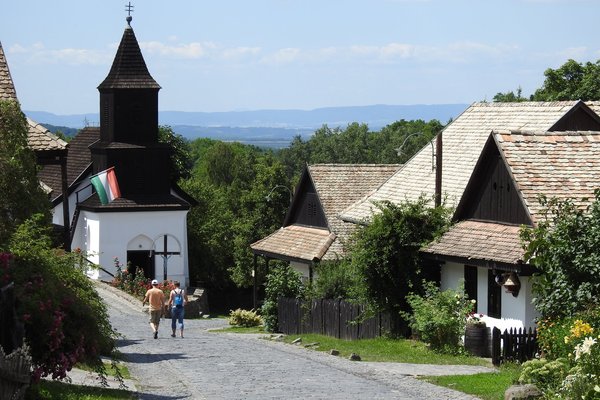Hungary
Hollókö
The Old Village of Hollókö and its surroundings is a living example of rural life before the agricultural revolution of the 20th century.
Hollókö is a Palóc ethnographic village, an ethnic minority group in north-east Hungary. The village developed mainly during the 18th and 19th centuries and has preserved its half-timbered architecture. The surroundings include strip-field farming, orchards, vineyards, meadows and woods.
Community Perspective: Solivagant’s review of a visit in 1986 still gives a glimpse of the site’s communist era. Then and now it is much geared toward receiving tourists and it’s almost a museum village. Stanislaw has explained how to visit on public transport.
Site Info
Official Information
- Full Name
- Old Village of Hollókö and its surroundings (ID: 401)
- Country
- Hungary
- Status
-
Inscribed 1987
Site history
History of Hollókö
- 2003: Name change
- From "Hollokö" to "Old Village of Hollókö and its surroundings"
- 1987: Inscribed
- Inscribed
- Type
- Cultural
- Criteria
- v
Links
- UNESCO
- whc.unesco.org
- Official
-
- holloko.hu — Holloko
- Related
-
- c3.hu — Link
All Links
UNESCO.org
- whc.unesco.org — whc.unesco.org/
Official Website
- holloko.hu — Holloko
Related Resources
- c3.hu — Link
News Article
- Feb. 14, 2024 hungarytoday.hu — The Buildings of Hollókő Restored
- May 6, 2015 hungarytoday.hu — Hollókő castle: reconstruction completed
- Oct. 11, 2014 hungarytoday.hu — Hollókö to shine even more (at EUR 6.5m cost)
Community Information
- Community Category
- Urban landscape: Post-medieval European
Travel Information
Budapest hotspot
Recent Connections
View all (13) .Connections of Hollókö
- Trivia
-
-
Minority communities
Palocz minority -
Depicted in Mizielinska Maps
See i.pinimg.com
-
- History
-
-
Sieges and Battles
Besieged by the Turks
-
- Architecture
-
-
Vernacular architecture
-
Timber framing
"traditional techniques of Palocz rural architecture: half-timbered houses on a stone base with roughcast white-washed walls" (AB ev)
-
- World Heritage Process
-
-
Perfect Inscriptions
1987 -
Inscribed on a single criterion only
v. to be an outstanding example of a traditional human settlement, land-use, or sea-use which is representative of a culture (or cultures), or human interaction with the environment especially when it has become vulnerable under the impact of irreversible change -
Extensions on Tentative List
The old villages of Hollókö and Rimetea and their surroundings (Romania)
-
- Religion and Belief
-
-
Legends and Folk Myths
Called the Raven Mountain due to the legend telling ravens destroyed the constructions of the village during its erection every night
-
- Human Activity
- Timeline
-
-
Built in the 17th century
After 1683
-
- WHS Hotspots
-
-
Budapest hotspot
One bus a day to make the return trip
-
- WHS Names
-
-
Name changes
Old village and surroundings added (2003)
-
News
- hungarytoday.hu 02/14/2024
- The Buildings of Hollókő Restored
- hungarytoday.hu 05/06/2015
- Hollókő castle: reconstruction com…
- hungarytoday.hu 10/11/2014
- Hollókö to shine even more (at EUR…
Recent Visitors
Visitors of Hollókö
- Adrian Turtschi
- Alberto Rodriguez Gutierrez
- Alexander Barabanov
- Alexander Lehmann
- A. Mehmet Haksever
- Andrea Szabo
- Argo
- Atila Ege
- Bamse
- BaziFettehenne
- Bin
- Bodil Ankerly
- Boj
- Bropyk
- c82wc1
- Carlos Sotelo
- Cezar Grozavu
- Christoph
- Claire Bradshaw
- Cluckily
- Clyde
- Csaba Nováczky
- CugelVance
- Dagmara
- daneva
- Dan Pettigrew
- David Berlanda
- David Marton
- Dimitar Krastev
- Dolemite92
- Dorejd
- Dr. Caligari
- Els Slots
- Erik Jelinek
- Errol Neo
- Eva Kisgyorgy
- fabi-ddorf
- Fan Yibo
- Felicité
- Gabor
- Geert Luiken
- George Gdanski
- GeorgeIng61
- GerhardM
- Gernot
- Harry Mitsidis
- henrik_hannfors
- hszaby
- Hubert
- Hurrvinek
- Iain Jackson
- Ilya Burlak
- Ivan Rucek
- Jacob Choi
- Jakob F.
- Janina Lehmann
- Jarek Pokrzywnicki
- Jeanne OGrady
- Jezza
- Joel on the Road
- Jonas Kremer
- jonathanfr
- Joyce van Soest
- Judit Andrea Juhász
- KarenBMoore
- Karito Vies
- Ken DJ
- Kerékgyártó
- Kurt Lauer
- kutasp
- Lara Adler
- Lisu Marian
- ljowers
- Luboang
- Lucas Del Puppo
- Luis Filipe Gaspar
- Maciej Gil
- Mahuhe
- Małgosia Łupicka
- Martina Rúčková
- Marton Kemeny
- MaYumin
- Michaela0705
- Michael Turtle
- Mikko
- Milan Jirasek
- Ming_9734
- MMM
- nan
- Nihal Ege
- Nikolay Marinov
- Patrik
- Persian Globetrotter
- Peter Lööv
- Philipp Leu
- Philipp Peterer
- Pincze
- Piotr Wasil
- Purrfect
- Rafał Kałczuga
- Rahelka
- Randi Thomsen
- Roger Ourset
- Roman Bruehwiler
- Roman Raab
- Schnitzel
- Sergio Arjona
- Shandos Cleaver
- Slavi
- Solivagant
- Sorel Americo
- Stanislaw Warwas
- Svein Elias
- Szabolcs Mosonyi
- Szabo Viktoria
- Szucs Tamas
- Tamara Ratz
- Taotao Chen
- Tarquinio_Superbo
- Tcchang0825
- Tevity
- Thomas Buechler
- Thomas van der Walt
- Tim Allen
- Timothy C Easton
- Tom Flaten
- triath
- Tsunami
- Vanessa Buechler
- WalGra
- Wojciech Fedoruk
- Wo_ko
- YaroMir
- Yevhen Ivanovych
- Yi Han Goh
- Zoë Sheng
- Zsuzsanna Forray
Community Reviews
Show full reviews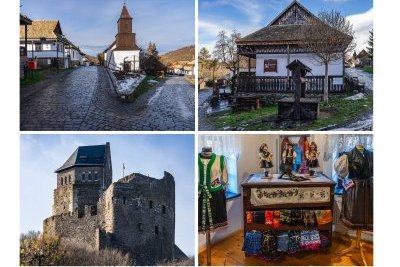
Visited in November of 2024. Something that is 300 years old and deliberately well-preserved always piques my interest, even if it has a reconstructed-for-museum-purposes feel. In any case, Hollókő is very photogenic and pleasant to walk through.
That old village core is literally just a few hundred meters long, with the homogenous nature of construction seen on every step. The signature sight is the town church, dedicated to St Martin, which sits at the fork of the only street in the village, splitting it into a main artery and an auxiliary loop. The door was locked, and I did not make extra efforts to find somebody to let me in.
In fact, of various tourist-catering establishments on the central stretch of the main street, most can be visited only between March and October. Just a couple stay open year-round. One is the "main" Village Museum, showcasing the traditional decorations, furniture, houseware, and tools; the other is Guzsalyas, the museum of traditional clothing. Both add a bit of historical context, so they are worth a look. (On a semi-related note, only one place was open for refreshments on that late-November morning - a pretty pastry shop called Kalácsos Pékség; several locals came in for their bread and pastry purchases while I had coffee and a fantastic local specialty whose name I did not record in its cozy dining room.)
The theme continued with craftsmen - only the leather workshop was operating on the day - but when I …
Keep reading 0 comments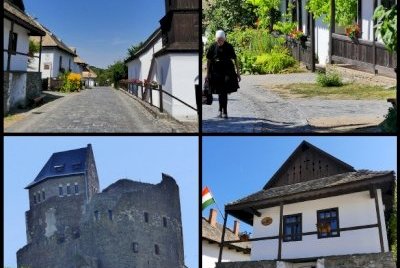
I visited this WHS in 2022 on two separate days, the second simply because I happened to be passing close by so I did a quick revisit (not that it was "necessary". Holloko is Hungary's version of Holasovice and together with Vlkolinec in Slovakia and perhaps Cumalikizik in Turkey covers vernacular architecture. It has a slightly better feel of a little village than Holasovice (a pretty square and a pond) but still overall is quite weak and apart from being almost a museum village, it is practically reconstructed (I've seen at least two house being rebuilt with a concrete core, then diligently covered with straw and white plaster.
That said, I must say that overall my visit was rather pleasant and luckily I didn't encounter any group tours. Many of the village houses have been converted to different museum or workshops, exhibiting or selling dreamcatchers, dolls, honey, postal stuff, crops and rural stuff, pottery, knitware, etc., while another two have been converted to a cafeteria and/or restaurant. I visited a couple just to see the houses' interior hoping to be surprised by the interiors (as was the case in Halsingland in Sweden) but there wasn't much to see inside except for very few hints of painted wooden decorations or carvings on beds, chairs, and small furniture from the local Palocz folk tradition. Perhaps, timing your visit with local festive days when the men and women of Holloko (and nearby) wear their traditional costumes would help to enjoy the place …
Keep reading 0 comments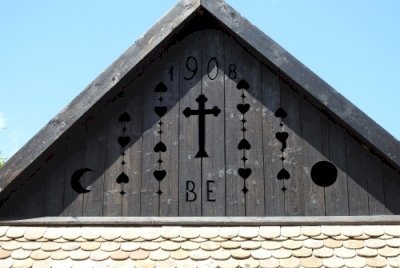
Hollókő is a traditional agricultural settlement of the North Hungarian Palóc community. The village consists of whitewashed half-timbered houses, which originated in the 17th and 18th centuries. It was completely rebuilt after a fire in 1909. The town was the first stop on my long weekend to Eastern Hungary, where I aimed to tick off 3 suspiciously low-ranked WHS.
I had some difficulty getting there. It should only be an hour's drive from Budapest airport, but there were lots of impediments:
- my flight already arrived with a delay of 10 minutes,
- the rental car parking space had moved to a faraway place beyond the Ibis hotel,
- I lost my ticket to exit the parking so I had to go back to the Hertz counter for a new one,
- there was no satnav in the rental car, so I had to use my phone…. for which I forgot to bring the charger!
- using GPS for navigation the phone battery doesn't last much longer than a few hours, so I was already thinking of buying an old-fashioned map at a gas station; luckily I passed a large shopping mall where they actually had an iPhone charger for sale,
- Waze for some unexplainable reason sent me on minor roads (I even drove on a parallel road next to the highway ...).
- But in the end I got there, some 2 hours later than planned. Hollókő presented itself as a small village with a very …
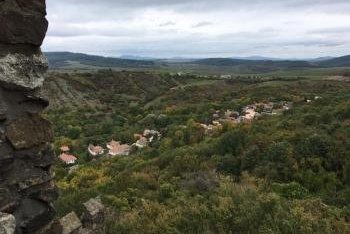
Visited October 2017.
Hollókő is a Palóc ethnographic village in the northern part of Hungary. It can be visited as a day trip from Budapest – there are two buses a day leaving from Stadion bus station (metro station: Puskas Ferenc Stadion). The mornig bus leaves at 08:30 and it takes two hours to get to the village which is hidden somewhere at the end of the road in one of Cserhat mountains valleys. Then you’ll have 5 hours and a half there, ‘cos the returning bus is at 4pm. You have plenty of time to see everything in the area – walk back and forth the two little streets, visit the church that was reconstructed in 1909 after the fire, visit all the museums in the village (village museum, dolls museum, post museum, weaving place, craft shops – for all of them you have to pay a minimal entry fee), follow the educational trail and learn about the local nature and local way of life, climb to the (partly reconstructed) 13th century castle for nice views, although the village itself cannot be clearly seen because of the forest that surrounds it (photo).
There is a new Tourist information centre at the entrance to the village, close to the parking lot, just behind the cemetery where you can get a map and some leaflets about Hollókő and activities and feasts in the area.
At the end of your tour you can have a local meal in one of the restaurants …
Keep reading 0 comments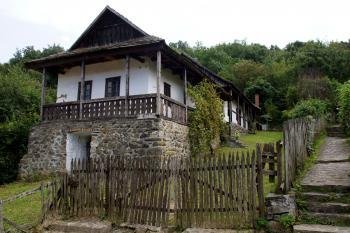
Hollókõ is a fine example of vernacular architecture, which has remained virtually unchanged for centuries. Although the village was burned down several times, it was always restored in the style of the 17th century. Only after the last large fire in 1909 the thatched roofs have been replaced with tile roofs.
The old village consists of about 60 residential houses with farm buildings and a small parish church, the modern village is right next to it. The single long street forks at the small church creating a lens-shaped "island" in the middle of the settlement. The plastered half-timbered houses have a stone base and most of the houses have overhanging porches and galleries or a veranda on the street side. The photo shows a typical example. The architecture is similar to the houses in Vlkolínec (also a WHS), but Hollókõ appears more elegant due to the white-washed walls and the verandas.
Another difference to Vlkolínec is that Hollókõ is more developed to tourism, there are several museums, craftsmen exhibitions, a restaurant and facilities for accommodation. Most interesting is the Village Museum (Falumúzeum), where the traditional interior layout with three separate rooms and historic furnishing can be seen. Fortunately it was not too busy when we visited Hollókõ on a weekday in August 2014, there were only about ten private cars in the parking lot and about thirty visitors spread over the village. But Hollókõ is a popular destination for group tours (it's just 100 km from Budapest), so it can …
Keep reading 0 comments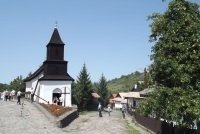
A very tidy village full of traditional architecture and a few villagers selling handicrafts. I reached the site by bus from Paszto station. Paul will be relieved to know that there is only a small car park up the hill from the bus stop. There is one restaurant, and a handful of the houses offer accommodation.
Keep reading 0 comments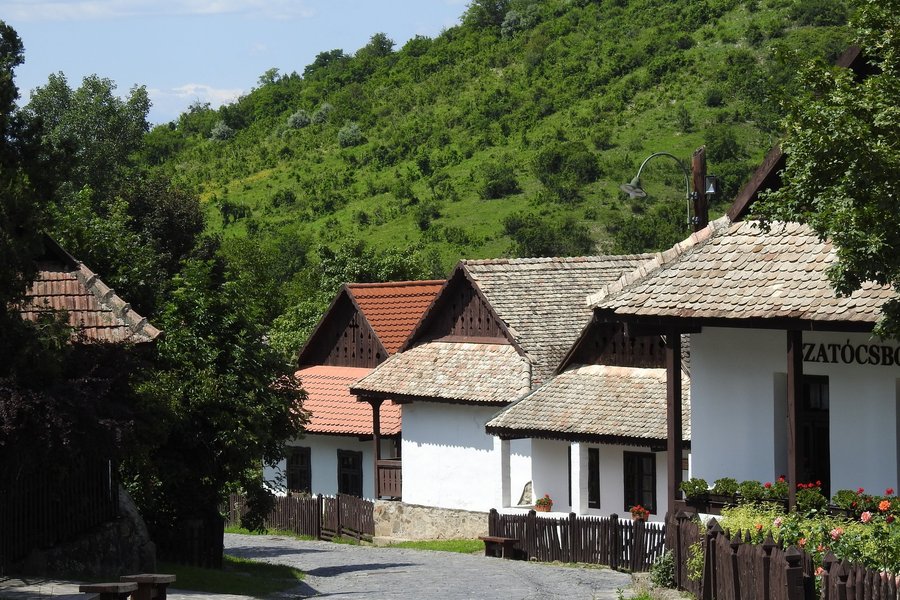
Holloko in Hungary is a very charming, well-preserved old world village. It welcomes visitors and tours of the village are available. Our group was invited to a local home for lunch and the owners were a wonderful older couple who obviously were very proud of their home and garden.
It was a delightful afternoon and I would heartily encourage tourists to take this excusion and see the wonderfully preserved wooden houses. We were on an organized tour from Budapest and were so happy to have had this experience.
Keep reading 0 comments
Visited May 26th, 2009
Went with three Hungarian friends as a day trip from Szolnok. Weather was clear and the village was quiet. The wooden houses are really beautiful and well-preserved.
When we visted the castle on the hill, we met several groups of very young students, obviously on school trip.
Back in the village, check the souvenir stores for ceramics. They are reasonably priced and pretty.
Keep reading 0 comments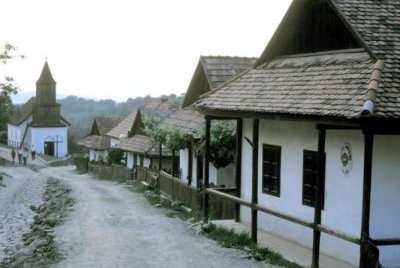
The preserved village of Holloko is set a convenient return day trip’s distance from Budapest. When we visited it in 1986 towards the end of the communist era it was certainly very “pleasant to the eye” but we didn’t find the visit that satisfying. The site is so much more than just a street of pretty wooden houses with a church at the end. The local “Palosz” people ignored agricultural and social changes going on elsewhere and in so doing “preserved” not only the buildings but a way of life from the 18th and 19th centuries. The site includes all the surrounding lands with their multitude of uses and where these were lost, such as with strip fields, they have been restored .
However, whilst communism sat less heavily upon Hungary than on many Soviet satellites, everything in those days was organised for group tourism, often under the pervasive banner of IBUSZ the “Intourist” of Hungary. So this museum village with its old fashioned rural atmosphere was organised for coach parties who were given a quick walk round, a visit to the church, a Hungarian meal at “the” tourist restaurant and a bit of “folklorique” from locals dressed up in Palocz costume.
We were self driving around Hungary and had thought of staying overnight at one of the local houses which acted as hostels in those days – but no one seemed interested in handling a couple of Western Europeans so we moved on (perhaps our lack of …
Keep reading 0 comments
